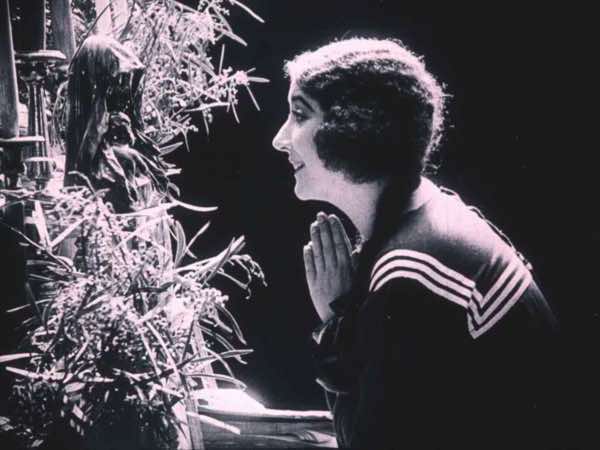TRAPPOLA
Eugenio Perego (IT 1922)
Synopsis The life and loves of Leda, from orphan in a convent boarding school to film star, narrated through the pages of her diary and her correspondence with her best friend. Leda falls in love with her friend’s fiancé, but a timely letter brings the situation to a satisfactory conclusion for everyone.
This sparkling comedy – at times verging on farce – is one of over 40 films directed by Eugenio Perego (1876–1944) between 1913 and 1929, shot in the same Lombardo Film studios and Campania region as the others in his successful series of films in the Neapolitan vein (Vedi Napoli e poi muori, Napule…e niente cchiù, Napoli è una canzone). While his most famous film probably remains Il padrone delle ferriere (1918), with Amleto Novelli and Pina Menichelli, it was his greatest success, Santarellina (1923; based on the operetta Mam’zelle Nitouche), which established Leda Gys (1892-1957) as the period’s most popular and best-loved diva, whose spontaneous and natural acting style enabled her to avoid the clichés of Italian silent film, too often inspired by inflexible excess in the overblown D’Annunzian mode. Gys was a versatile actress, able to move easily from melodrama to comedy, and even impish mischievousness, as this film demonstrates. Extremely photogenic, her face was portrayed many times by the famous poster artist Anselmo Ballester.
From 1924, with Profanazione, Gys went on to star in all of Perego’s films. It was the Roman dialect poet Trilussa [Carlo Alberto Salustri], her early partner, who coined her stage name, an anagram of her real name, Giselda, and arranged her first auditions. Progressing from small parts at Cines to bigger roles with Caserini Film, Gys gave one of her best performances as the Madonna in Giulio Antamoro’s Christus (1916). In 1919 she signed with Lombardo Film, founded by Gustavo Lombardo (1885-1951), with whom she embarked upon an artistic and romantic association, crowned in 1920 by the birth of their son Goffredo, the future head of Titanus, the successor to Lombardo Film.
“This is a amiable and stinging satire on certain ‘prima donnas’ of the cinema, maudlin or worse. Leda Gys pokes fun at her colleagues with grace and good taste. The film reveals many risqué backstage scenes at the studios, showing the audience the Eleusinian mysteries of film-making.” (La Stampa, Turin, 03.01.1923)
“Also known as In trappola, the film ran into difficulties with the censors: ‘Cut or shorten the scene in which Leda dances on the kitchen table, surrounded by the other schoolgirls;that in which, before she runs away, she appears in a chemise and then in knickers; when Leda is in prison with a group of no-goods; and that scene repeated several times of kisses exchanged by Claudio and Furetta in unseemly poses.’ ” (Vittorio Martinelli, Il cinema muto italiano. Il cinema degli anni venti, 1921-1922. Bianco & Nero, Rome, 1996)
Luisa Comencini

photog: Victor Armenise.
cast: Leda Gys (Leda Bardi), Suzanne Fabre (Furetta), Gian Paolo Rosmino (Claudio Mari), Claudio Mari (Claudio), Carlo Reiter (duca di/Duke of Manforte), Ernesto Masucci (Don Bernardo), Giovanni Raicevich.
prod: Lombardo Film, Napoli.
v.c./censor date: 31.05.1922 (n. 17019).
première: 06.06.1922 (Roma).
copia/copy: 35mm, 1314 m. (orig. 1596 m.), 52′ (22 fps), col. (imbibito/tinted); did./titles: ITA.
fonte/source: Cineteca Italiana, Milano.
Restauro/Restored: 1999, da un negativo originale/from an original negative (lab. L’Immagine Ritrovata, Bologna)


 Italiano
Italiano